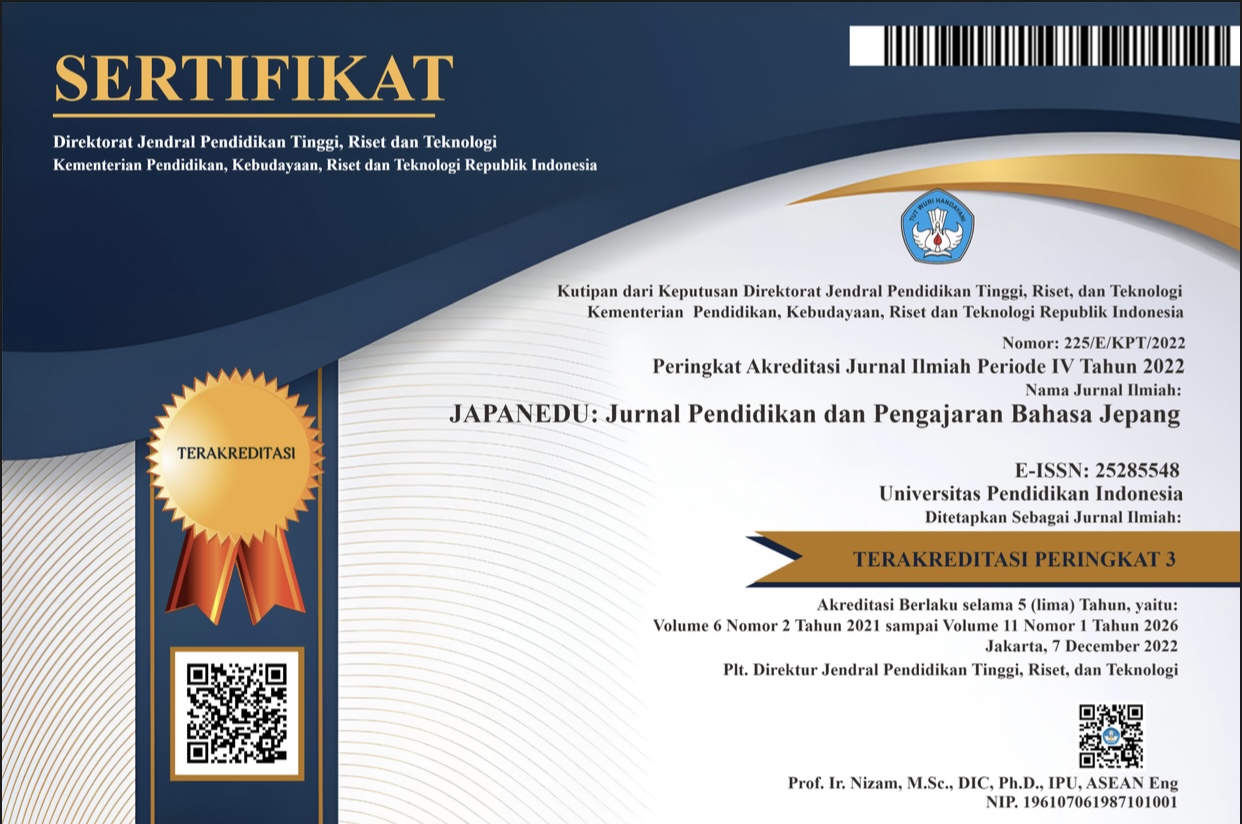A Contrastive Analysis of Emotive Interjection (Kandoushi) in Japanese and Indonesian
Abstract
Kandoushi is a word that expresses an impression, also called “interjection” in Indonesian, and is one type of emotive interjection. This study examines the meaning and use of emotive interjection, and its similarities and differences in Japanese and Indonesian. The method in this study used a descriptive contrastive analysis method with the note-taking technique. The data is taken from the dialogue in the Japanese anime “ReLIFE” and the Indonesian TV series “Tetangga Masa Gitu” and “Bajaj Bajuri”. The results of the study showed that the emotive interjection in Japanese and Indonesian had several similar meanings, particularly expressing feelings of pleasure, admiration, annoyance, confusion, and distress. Then, both of them have the same use, which is used to confirm the speech partner’s expression, is used to conclude something, is used to protest against the speech partner, is used to show approval, and is used to realize something. Interjection comprehension is very important in understanding an utterance intent in a conversation so that communication can take place with native speakers or fellow foreign students. This study only examines the interjections in terms of the emotive feeling/impression of being surprised. Therefore, for future research, it is expected to research form, meaning, and the use of other interjections in terms of phonology.
Keywords
Full Text:
PDFReferences
Alwi, H., Darjowidjojo, S., Lapoliwa, H., & Moeliono, A. M. (2000). Tata Bahasa Baku Bahasa Indonesia (edisi ketiga) [Indonesian Standard Grammar (third edition)]. Jakarta: Kementrian Pendidikan dan kebudayaan.
Breadsmore, H. B. (1982). Bilingualism: Basic Principles. Tieto: Avon.
Djomi, A. H. R. (2017). Analisis Kandoushi (Kata Seru) dalam Bahasa Jepang yang Menyatakan Kandou pada Komik Boku Dake Ga Inai Machi Volume 1-6 (Kajian Pragmatik) [Analysis of Kandoushi (Exclamation) in Japanese Expressing Kandou in Comic Boku Dake Ga Inai Machi Volume 1-6 (Pragmatic Study)] (Thesis). Fakultas Ilmu Budaya, Universitas Dipenogoro.
Fishman, J. A. (1972). The Sociology of Language: An Interdisciplinary Social Science Approach to Language in Society. First Published. Newbury House Publishers, Massachusetts.
Hayashi, T. (2013). The effect of conceptualization on the pragmatic meaning of politeness. Studies in Pragmatics, 15, 57–78.
Hymes, D.H. (1972). Models of The Interaction of Language and Social Life. New York: Holt, Reinhart and Winston Inc.
Isnavia, T. (2019). Analisis Yobikake Dalam Anime Kiseijuu Sei No Kakuritsu [Yobikake’s Analysis in Kiseijuu Sei No Kakuritsu Anime](Thesis). Fakultas Bahasa dan Seni, Universitas Negeri Semarang.
Kohno, T. (2019). Nihongo ni okeru Kandoushi to Intoneeshon no Koukyuu: Kanrensei Modaritii no Fuuzei. - A symphony of interjections and intonations in Japanese: Flavors of relevance modalities. Bulletin of Otsuma Women’s University – Humanities, 51.
Kridalaksana, H. (1994). Kelas Kata dalam Bahasa Indonesia [Class Words in Indonesian]. Jakarta: Gramedia.
Lubis, A. H. H. (2015). Analisis Wacana Pragmatik [Pragmatic Discourse Analysis]. Bandung: Angkasa.
Masuoka, T. dan Takubo, Y. (1993). Kiso Nihongo Bunpou [Basic Japanese Grammar]. Tokyo: Kuroshio Shuppan.
Namatame, Y. (1996). Nihongo Kyoushi No Tame No Gendai Nihongo Hyougen Bunten [Contemporary Japanese Expressions for Japanese Teachers]. Japan: Kabushiki kaisha Hojinsha.
Natasya, R. I. (2019). Analisis Kontrastif Interjeksi Perasaan Terkejut Bahasa Jepang ‘Kandoushi’ dengan Bahasa Sunda ‘Kecap Panyeluk’ dari Segi Makna dan Penggunaan. Skripsi, Fakultas Pendidikan Bahasa dan Sastra, Universitas Pendidikan Indonesia.
Shalika, M. P. & Mulyadi, M. (2019). Cognitive interjection in Indonesian and Japanese. Humanika: 32-39.
Sperber, D. & Wilson, D. (1986). Relevance: Communication and Cognition. Blackwell: Oxford.
Sudjianto. (2003). Gramatikal Bahasa Jepang [Japanese Grammatical]. Jakarta: Kesaint Balnc.
Sutedi, D. (2011). Dasar-dasar Linguistik Bahasa Jepang [Fundamentals of Japanese Linguistics]. Bandung: Humaniora.
Takubo, Y. (2005). Kandoushi [Interjection]. Gengo 11-Tokushuu: Kandoushi, 34(11), 412.
Thompson, L. (ed). (1997). Children Talking. The Acquisition of Pragmatic Competence. Clevedon: Multilingual matters.
Qomariana, Y., Puspani, I. A. M., & Rahayuni, N. K. S. (2019). Kesalahan gramatikal karena pengaruh bahasa ibu dalam tulisan mahasiswa Program Studi Sastra Inggris Fakultas Ilmu Budaya Universitas Udayana [Grammatical errors due to the influence of the mother tongue in the writing of students of the English Literature Study Program, Faculty of Cultural Sciences, Udayana University]. Pustaka Jurnal-Jurnal Ilmu Budaya, 19(2), 112-117.
Yule, G. (1996). Pragmatics. Oxford: Oxford University Press.
DOI: https://doi.org/10.17509/japanedu.v7i2.52222
Refbacks
- There are currently no refbacks.
Copyright (c) 2022 JAPANEDU: Jurnal Pendidikan dan Pengajaran Bahasa Jepang

This work is licensed under a Creative Commons Attribution-ShareAlike 4.0 International License.
 Published by:
Published by: Department of Japanese Language Education, Faculty of Language and Literature Education
Universitas Pendidikan Indonesia
 Online ISSN: Online ISSN:2528-5548 |

JAPANEDU: Jurnal Pendidikan dan Pengajaran Bahasa Jepang (e-ISSN:2528-5548) lisenced under a Creative Commons Attribution-ShareAlike 4.0 Internasional (CC BY-SA 4.0)


